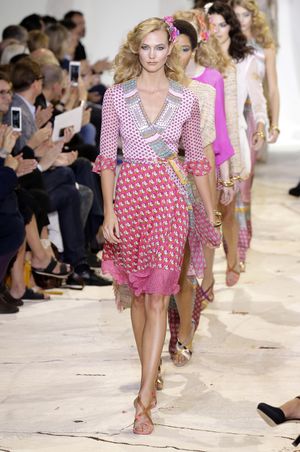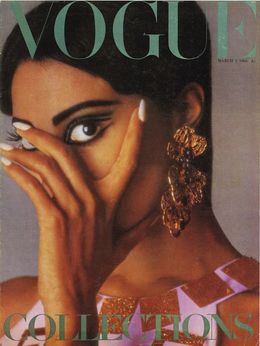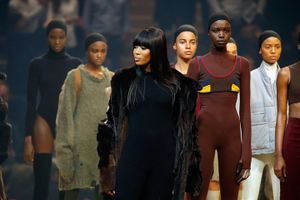GRSJ224/The Underrepresentation of African American Models in the Fashion Industry
GRSJ224 Wiki Entry: Sharon Michaeli
Although Discrimination has many forms, models within the fashion industry have been specifically facing racial discrimination. "Racial discrimination refers to unequal treatment of persons or groups on the basis of their race and/or ethnicity" (p.182) [1]. This is specifically evident through the casting processes, photo editing procedures, and personal experiences of African American models within the industry.
The fashion industry has always had a tremendous influence on women all of the world. The underrepresentation of African American models in fashion magazines has been more than evident throughout the years. Women of all racial descents have been physically changing their exterior characteristics to match those in the covers and content of influential fashion magazines such as Vogue, Elle and Glamour. Women of all colours and sizes have been negatively influenced by the accepted portrayal of women in the industry. African American models however, have been specifically influenced to conform to white beauty and fit into the white aesthetic. Although many African American models dislike or disagree with the procedures they must undergo in order to be featured or hired within the fashion industry, they are taught from a very young age that they must alter their natural look in order to succeed.
The appearance of African American models in fashion shows, magazines, galleries, and other fashion platforms/outlets have been evidently limited. During the 2013 New York Fashion Week only 6% of models were African American while 82.7% were Caucasian [2]. Prior to the 2009 election of president Obama, African American models appeared on the cover of Vogue and Glamour magazines every five to ten years [3].
Casting African American Models
The casting of African American Models is a very selective and exclusive process. Casting directors of influential fashion platforms often racially categorize models without explicitly calling for models with a specific ethnicity. “ethnic” models will often be requested when these professionals desire African American models, or models of other ethnicities such as Latinas and Asians, while requesting an “All- American” model when they desire a Caucasian model with light hair and eyes [4].
Altering Physical Characteristics
African American Models, as well as African American Women in general, spend a great amount of time and money on skin bleaching products, hair relaxers, and wigs. These expensive beauty procedures are, at times, very painful and very time consuming [3]. The iconic African American models exclusively selected to feature in Vogue and Glamour magazines such as Naomi Campbell, and famous singers Beyoncé and Rihanna, have clearly been physically modified to fit into the accepted image in the industry. Lightened skin, died and pressed hair, as well as long wigs are all common garnishments to the physical looks of these models [3].
Recent Misrepresentation of African American Models in Fashion Magazines
Perry Ellis (2015)
After the President of Perry Ellis demanded that no African American or homosexual models be featured in the advertisements, the company was sued for discrimination in 2015. Ellis was sued due to him discriminatory behaviour, attitude, and offensive overused racial slurs [5].
Lupita Nyong’o (2017)
After being featured on the cover of Grazia Magazine in November of 2017, the editors, photographers, and magazine editors decided to edit the Nyong’o’s hair, which at the time was pulled back into a puff ponytail, out of the images [6]. This hairstyle was deemed as undesired and unprofessional by the editors. Nyong’o later used her public platform to address this unacceptable issue and expressed her disappointment [6].
Timeline of Influential Models
Dorothea Towels (1950)
Dorothea Towels was the first African American models to walk Paris Fashion Week. During her earlier career, Towels was only featured on the covers of black magazines, bur was later discovered by Cristian Dior. Towels later started her own clothing company to which used African American models from black colleges across the United States [7].
Sara Lou Harris (1954).
Sarah Lou Harris was featured in the cover of 26 magazines and was the first black model to feature the New York Buyers Fashion Show. Represented by Branford Modeling Agency, the first licenced black modeling agency in the United Sates, Harris was one of twelve black models in the agency [8].
Donyale Luna (1967)
Donyale Luna was an inspiration for many iconic photographers after being declared one of the world’s most beautiful women in the 1960’s. Additionally, Luna was the first African American Models to feature on the cover of British Vogue Magazine and featured in several films created by Andy Warhol and Fellini Films [9].
Beverly Johnson (1974)
Beverly Johnson was the first African American model to feature in the cover of American Vogue Magazine in 1974. After receiving worldwide attention for her American Cover, other influential fashion magazines opened up their casting to a greater amount of African American models [7].
Karen Alexander (1989)
Alexander featured on the cover of the world’s most influential fashion magazines such as Vogue, Elle and Glamour. Additionally, Alexander was featured in Sports Illustrated Swimsuit Issue in both 1988 and 1989 and was considered one of the fifty most beautiful people by People Magazine in 1990 [7].
Naomi Campbell (1993)
Naomi Campbell is now considered one of the greatest African American Supermodels in the world. After being discovered at the age of fifteen, Campbell was featured on the Cover of Elle Magazine in 1886 and later was the first African American Model to land the cover of Paris Vogue Magazine. Additionally, Campbell was the second African American model to be featured on the cover of British Vogue Magazine [7].
Tyra Banks (1996)
Tyra Banks is one of the most known African American models in the world. During her first Paris Fashion Week Banks was booked for one twenty five different fashion shows as every high end designer such as Christian Dior and Chanel admired her look and walk. This achievement broke the record for the most fashion shows book for a first year model ever [7].
Jessica White (2005)
Jessica White has been featured in many influential fashion magazines such as Sports Illustrated Magazines throughout her career. White became a symbol in pop culture after becoming one of Victoria Secrets most well known Angels [7].
Winnie Harlow (2014)
Winnie Harlow was and has been a significant figure in the fashion industry and pop culture since 2014 when the model was first features on the TV reality show America’s Next Top Model ANTM). After being diagnosed with Vitiligo, a skin condition causing depigmentation, she was brutally bullied throughout her schooling career [10]. After her appearance in ANTM, Harlow was applauded and admired for her skin condition and beauty. Today, Harlow is featured in multiple influential magazines and has over five million followers on Instagram [10].
Inclusive Designer Brands
Yeezy (Kanye West)
Kanye West, a famous rap singer and fashion designer, broke the "traditional" fashion show guidelines during his 'Yeezy Season 3' fashion show in 2016 by exclusively casting racially diverse models. West's fashion show was the most diverse show during the 2016 fall season [11]. To this day, Kanye West continues to present diversity in all his fashion shows, campaign and advertisements [11].
Balmain (Olivier Rousteing)
Olivier Rousteing, the head designer of fashion brand Balmain has influenced many different skin tones, races, and ethnicities during his fashion shows since he’s landed the exclusive role [12]. Additionally, Rousteing illustrated his support for racial diversity during the 2018 Cannes Film Festival by dressing sixteen black actresses and taking a part in the “Black is Not My Profession” project [13].
Implications
As the fashion industry is such an influential platform, the effects it has on individuals across the world is tremendous. The representation of African American women and their accepted image is projected to young audiences and negatively influences their experiences, self-esteem, and confidence [14]. Young women, men, and individuals of all colours, races, and ethnicities are influenced by this type on discrimination on a daily basis [14]. Society’s idea of beauty, which is shaped by the fashion industry, has caused many African American women to undergo painful procedures in order to alter their physical appearance and fit into an unrealistic figure of beauty.
References
- ↑ Pager, Devah; Shepherd, Hana (March 17, 2008). "The Sociology of Discrimination: Racial Discrimination in Employment, Housing, Credit, and Consumer Markets" (PDF). Annual Review of Sociology. 34 (1): 181–209 – via JSTOR.
- ↑ Covert, Bryce (August 9, 2013). "The Fashion Industry's Race Problem: Models Of Color Rarely Get Hired". Think Progress.
- ↑ 3.0 3.1 3.2 Vikhrenko, Elizabeth (2017). "The Color Divide: Representation of Skin Color in American Fashion Publications". ProQuest Dissertations Publishing: 1–45 – via ProQuest. Cite journal requires
|journal=(help) - ↑ Wissinger, Elizabeth A. (September 18, 2015). "This Year's Model: Fashion, Media, and the Making of Glamour". Cambridge University Press and British Association for American Studies. NYU Press: 351 – via NYU Scholarship Online.
- ↑ "Perry Ellis President Sued After Demanding "No Blacks, Gays in Ads"". The Fashion Law. October 22, 2015.
- ↑ 6.0 6.1 Gibson, Cristina (November 13, 2017). "Lupita Nyong'o Is 'Disappointed' a Magazine Photoshopped Her Natural Hair, Photographer Responds to Controversy". Us Magazine.
- ↑ 7.0 7.1 7.2 7.3 7.4 7.5 "The History Of Black Models". Essence. January 30, 2012.
- ↑ Guyanese Girl (November 10, 2012). "A Piece Of History: The Lady Sara Lou Carter Charm School For Girls In Guyana". guyanesegirlsrock.
- ↑ Sarazen, Lauren (February 12, 2018). "The Model Who Broke Barriers as Vogue's First Ever Black Cover Girl". Broadly.
- ↑ 10.0 10.1 Strang, Fay (November 7, 2018). "MODEL BEHAVIOUR Who is Winnie Harlow? Lewis Hamilton's friend and model who's embraced vitiligo condition". TheSun.
- ↑ 11.0 11.1 Tai, Cordelia (September 6, 2016). "Kanye West Invites "Multiracial Women Only" to Model Yeezy Season 4, We Cringe". The Fashion Spot.
- ↑ Tate, Crystal (September 29, 2017). "All Of Our Favorite Black Models Hit The Runway At Balmain's Spring 2018 Show". essence.
- ↑ Sidell, Misty White (May 16, 2018). "Balmain Takes a Stand for Racial Inclusivity at Cannes". WWD.
- ↑ 14.0 14.1 Brennan, Siofra (July 4, 2017). "'You are beyond beautiful': Sudanese model dubbed the Queen of the Dark encourages black women to love their skin - after an Uber driver asked if she'd bleach herself for $10K". Mail Online.



